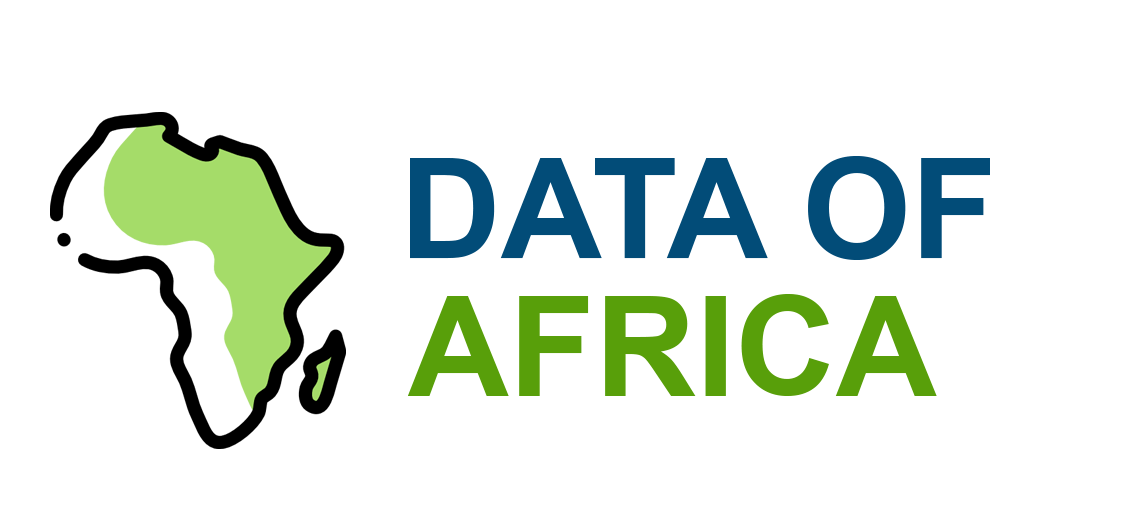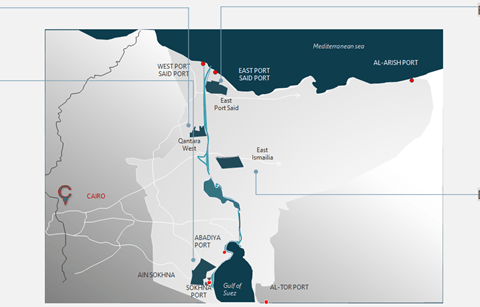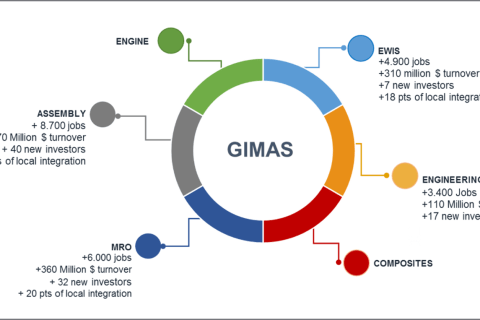-
Grand Inga (DRC)
Powerful hydroelectric project (potential ~39 GW). Challenges: supplying energy to landlocked regions, reducing dependence on fossil fuels, and exporting to South Africa and Europe. Expected benefits: massive electrification, industrial growth, job creation, and regional infrastructure.
-
Grand Ethiopian Renaissance Dam (Ethiopia)
Dam on the Blue Nile (~6 GW). Issues: energy sovereignty, irrigation, flood control. Benefits: hydraulic stability, agricultural development, political tension/settlement with Egypt and Sudan.
-
Suez Canal – Extension (Egypt)
Extension and doubling of the canal since 2015. Challenges: increase capacity and reduce ship waiting times. Benefits: +30% traffic, doubled revenues, strengthening Egypt’s role in global trade.
-
New Administrative Capital (Egypt)
Creation of a new city 45 km from Cairo. Challenges: urban decongestion, economic recovery, international image. Benefits: transfer of ministries and institutions, modern housing, potential attraction of investment and expatriates.
-
Al Galala & New Alamein (Egypt)
Two integrated seaside towns on the Mediterranean. Challenges: tourism diversification, revitalization of the real estate market, job creation. Benefits: new seaside resorts, port and airport infrastructure, and regional revitalization.
-
Konza Technopolis (Kenya)
A 5,000-acre smart city located 60 km southeast of Nairobi, launched as part of Vision 2030. Challenges: stimulate ICT growth, attract investors and startups, create 240,000 jobs by 2030, improve STEM education. Benefits: “Silicon Savannah” regional hub, new university centers, sustainable infrastructure, +2% of national GDP
-
Standard Gauge Railway (Kenya – Mombasa–Nairobi)
480 km SGR line, inaugurated in 2017, connecting the port of Mombasa to Nairobi. Challenges: speed up passenger and freight transport, relieve coastal congestion, connect East Africa. Benefits: journey time reduced from more than 10 hours to 4 hours, 22 Mt/year of freight capacity, 14 bridges fertile for wildlife
-
LAPSSET Corridor (Kenya–Ethiopia–South Sudan)
Multimodal corridor (rail, pipeline, road, ports) of approximately 3,000 km and worth $25 billion. Challenges: connecting the Lamu Gulf to the interior, diversifying trade routes. Benefits: regional integration, new mining opportunities, securing exports.
-
Second Niger Bridge (Nigeria)
A 1.6 km bridge + 10 km of access roads linking Onitsha (Anambra) to Asaba (Delta), inaugurated in 2022. Challenges: relieve congestion on the only existing bridge, improve traffic flow, and boost the East-West corridor. Benefits: creation of 8,000 direct/indirect jobs, reduction in traffic, growth of local trade.
-
Dangote Oil Refinery (Nigeria)
A 650,000 b/d mega-refinery in Lekki, near Lagos, to be inaugurated in May 2023. Challenges: Stop imports, produce gasoline, diesel, kerosene, and jet fuel. Benefits: Energy self-sufficiency, creation of over 250,000 jobs, annual savings of ~$25–30 billion.
-
Mambilla Hydroelectric (Nigeria)
A 3,050 MW dam-network project (4 dams, 2 underground power plants) on the Donga River in Taraba State, costing ~$5.8 billion. Challenges: Strengthening national electricity supply, reducing power outages. Estimated benefits: 4.7 TWh/year of production, 50,000 jobs, and integration into the national grid via 700 km of lines.
-
Sambangalou Hydroelectric Dam (Senegal)
108 m dam, 128 MW capacity, 4 billion m³ reservoir on the Gambia River, estimated completion in 2025. Challenges: renewable energy, irrigation of 90,000 ha, access to drinking water. Benefits: agricultural development, biodiversity preservation, ~1,200 construction site jobs.
-
Lobito Corridor (Angola–Zambia–DRC)
A ~1,300 km rail corridor from the port of Lobito (Angola) via the DRC to the Zambian Copperbelt. Challenges: unlocking mineral exports and strengthening regional integration. Expected benefits: revitalization of infrastructure, job creation, and attractiveness of EU/US funding.
-
Bagamoyo Port (Tanzania)
Dar es Salaam North Deepwater Port Project, linked to the SEZ and airport. Challenges: Decongesting Dar and capturing regional traffic. Potential benefits: Up to 20 million TEUs/year, industrialization, jobs, and local added value.
-
Ponta Techobanine Railway (Moz, Bots, Zim)
An approximately 800-km rail line connecting southern African mines to a Mozambican port. Challenges: exploiting minerals and diversifying routes. Benefits: stabilized exports, boosting mining economies, and an estimated investment of approximately $6.5 billion.
-
Mozambique LNG – Coral South
Floating LNG plant of 3.4 Mt/year off the coast of northern Mozambique. Challenges: Offshore gas development, export to Europe/Asia. Benefits: +4,500 jobs, high tax revenues, development of local skills.
-
Noor Midelt Solar Complex (Morocco)
800 MW hybrid solar power plant (CSP + PV) in the Middle Atlas. Challenges: energy transition, sustainable mix. Benefits: decarbonization, grid stabilization, specialist training, support for national renewable energy.
Here is the fifth wave with the last two structuring projects (19 and 20), written in synthetic format (~300 characters), including image + map:
-
Nigeria–Morocco Gas Pipeline
5,600–6,800 km of coastal gas pipeline, connecting Nigeria to Morocco via 11–13 countries, budget ~$25–26 billion. Feasibility studies and engineering approved in 2025, creation of an SPV expected. Challenges: valorization of Nigerian gas, West African & European energy security. Benefits: supply of up to 30 Gm³/year, territorial energy, employment and industrialization for 400 million people.
-
Mauritania–Mali HighVoltage + solar
High-voltage power line project (~1,373 km) coupled with a solar power plant (50 MW) between Mauritania and Mali, cost ~$900 million. Challenges: regional interconnection, grid stabilization, access to clean energy. Benefits: rural electrification, grid reinforcement, reduction of dependence on diesel generators.



